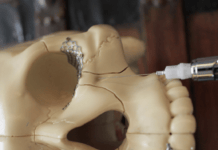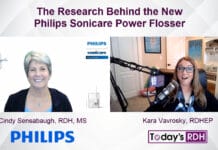As our understanding of the multiple links between the mouth and the body has increased, our roles have expanded to include care of the patient’s whole health. One aspect of whole health care that can have an enormous life-changing and life-saving effect is to screen for sleep-disordered breathing.
By discovering disordered sleep breathing, the dental professional can make a difference in the quality of life and even the longevity of the patient. Having that kind of impact can make our careers incredibly satisfying. Airway issues affect adults and children alike, and this article will focus on childhood sleep-disordered breathing. Adult sleep-disordered breathing will be the focus of my article next month in Today’s RDH.
Benefits of Nasal Breathing
Most studies show that nasal breathing is ideal breathing; especially since the nose and the paranasal sinuses are the primary sites in which our bodies produce nitric oxide, which is critical for whole-body health. 1 Nitric oxide plays an important role as a vasodilator, decreasing blood pressure and improving blood flow to the organs. It also contributes to the immune system, destroying viruses and parasites. Nitric oxide regulates the secretion of digestive hormones and enzymes, promoting a healthy digestive tract and regulates bladder function. Nitric oxide is also necessary for the regulation of binding and release of oxygen to hemoglobin.
Low nitric oxide is linked to diseases such as cardiovascular disease, irritable bowel syndrome and other digestive diseases, bladder problems, Alzheimer’s disease and dementia, and erectile dysfunction. Nasal breathing increases nitric oxide in the body, which helps to prevent and combat those diseases.2
However, there is a certain group of patients for whom mouth breathing is preferred. If the nasal airway is obstructed due to physical blockage from a deviated septum or other physical barrier, effective nasal breathing may be impossible. If the person with blocked nasal passages is forced to breathe through their nose, the body must work harder to get oxygen and to pump blood. In extreme cases, this can cause heart enlargement and death.3
Due to limitations in scope of practice and/or technology, dental professionals are not able to fully examine the airway. For this reason, we must rely on an otolaryngologist (ear nose and throat specialist) to determine if the nasal airway is clear enough for safe nasal breathing. If the airway is blocked, the ENT specialist can provide treatment to enable improved breathing.
Symptoms of Pediatric Sleep Disorders
The signs and symptoms of childhood sleep-disordered breathing relate to multiple different aspects of health, including medical health, mental health, dental health, and behavior. Many of these signs and symptoms are associated with general health, general mental and psychological health development, airway development, jaw development, and quality of sleep.4
“Clues” can be looked for in our patient’s medical history that should make us suspect possible sleep-disordered breathing, and they should lead us to question the child and the parent. As we listen to their answers and perform a clinical assessment, we can begin to “connect the dots.”
A questionnaire can be sent home with parents so that they may further observe their child. Once the questionnaire is complete, the dental professional would review the responses with the parent and be able to make an appropriate recommendation for a referral for medical diagnosis and treatment. The definitive test for diagnosis is a polysomnogram or sleep study. Treatment may include a CPAP device, an oral appliance, tongue-tie or lip-tie release, orthodontic expansion, tonsillectomy, nasal strips, nasal cones, a side sleeper positional pillow, or a combination of these.
Assessing Patients
The role of the dental hygienist is to identify possible sleep-disordered breathing and to bring that information to the attention of the treating dentist and the parent, so appropriate next steps can be taken to improve the child’s airway.
The following steps should be followed in assessing pediatric patients for possible airway restrictions.
Physical Assessment
In observing the patient in the reception room, pay attention to the child’s appearance and behavior:
- Dark under-eye circles
- Long, narrow face
- Small mandible
- Convex or concave facial profile (recessed chin or shallow mid-face)
- Forward head posture
- Active/alert or hyperactive/jittery or lethargic/slow
- Normal or average height/weight for age or short-stature/underweight
- Mouth open/mouth breathing
- Speaks with a lisp or other speech impediment
Questions for parents based on physical assessment
- Does your child put things in his/her mouth?
- Does your child lick his/her lips often?
- Does your child hang mouth open/breathe through his/her mouth?
- Does your child make noise while breathing?
- Does your child stick tongue out, thrust tongue forward, or dart the tongue out of the mouth?
- Does your child often have tongue resting between the teeth or bite lips or chew on the tongue?
- Does your child rest his/ her cheek on his/her hand?
- Does your child sit or stand with a forward head posture?
- Does your child seem to have low energy/daytime sleepiness?
- Has your child been diagnosed with ADHD or other behavioral or learning challenges?
- Does your child have trouble sitting still?
While eating:
- Does your child eat sloppily?
- Does your child gasp for air when eating?
- Does your child stick tongue out when swallowing?
- Does your child stick tongue out to meet the glass while drinking?
- Drink a lot while eating?
- Does your child take a breath before drinking?
- Does your child puff cheeks out while drinking?
- Does your child purse lips while swallowing food or drinks?
- Does your child tighten his/her chin while swallowing?
- Does your child dip his/her head when swallowing?
While talking:
- Does your child gasp for air when speaking?
- Does your child talk very fast or very slowly?
- Does your child speak with a lisp?
- Does your child take speech lessons or speech therapy?
While sleeping:
- Does your child sleep with his/her mouth open?
- Does your child sleep with his/her head tilted back?
- Does your child snore or breathe noisily?
- Does your child sleep restlessly or wake often?
- Does your child have a hard time waking up?
- Does your child exhibit daytime sleepiness?
- Does your child grind his/her teeth?
- Does your child wet the bed?
- Does your child have bad dreams or night terrors?
Medical History
We have always reviewed the health history looking for information that could be connected to oral conditions, or that could point to potential complications with treatment or even patient management. Now, we look even deeper into the health history to look for connections between oral health and overall health risks. In raising our awareness of childhood sleep-disordered breathing, we must scan the health history for clues to potential airway issues.
Does the child’s health history include medication for:
- Attention deficit hyperactivity disorder
- Anxiety
- Depression
- Defiance or oppositional behavior issues
- Allergies
- Sinus conditions
- Ear infections
- Headaches or migraine headaches
If any of the above conditions are noted, it’s important to question the child and parent further. The symptoms of ADHD, for example, are also signs of sleep-disordered breathing. It is believed that many people who are on stimulant medication for ADHD may not actually have ADHD but may be suffering from sleep-disordered breathing and the consequences of poor quality and poor quantity of sleep.
This is an emotionally charged issue, and I am absolutely not denying the existence or severity of ADHD. We owe it to children who are suffering from difficulty concentrating or focusing, and from impulsivity, and all of the other symptoms diagnosed as ADHD, to delve deeper into their sleep and breathing to be sure that we are not missing this important information, which could alter their entire experience and health. A lifetime on stimulant medications is not without side effects that can affect the child physically, mentally, and psychologically.
For those who are actually suffering from sleep-disordered breathing and not ADHD, this attention could be dramatically life-changing. The same can be said for anxiety, depression, and all of the above-listed conditions, as sleep disorders can present as these conditions, and when the airway is opened, many see these conditions disappear.
Questions for parents based on health history clues:
- Does your child have allergies, stuffy or runny nose, sinus problems, or ear problems?
- Does your child complain of ringing in the ears or dizziness?
- Does your child have a history of ear infections?
- Does your child have/have a history of tubes in the eardrum(s)?
- Does your child have a sore throat or a history of throat infections?
- Does your child have trouble swallowing pills?
- Has your child had the tonsils and/or adenoids removed?
- Does your child get headaches?
- Does your child complain of neck aches?
- Does your child complain of stomachaches?
- Does your child have dry or chapped lips?
- Does/did your child use a pacifier? Suck their thumb or finger(s) now or in the past?
- As a baby, was your child breast or bottle-fed? For how long was he/she breastfed?
- Was your child early or late to get teeth?
- Was your child hard to feed?
- Did your child refuse to chew food as a baby?
Intraoral Assessment
The most efficient way to perform a thorough airway assessment is to incorporate it as part of the routine comprehensive head and neck abnormality screening that should be performed for every patient at every appointment. It’s never too early to begin these screenings. It allows children to become comfortable with our touch, moving from a less invasive examination of the face and neck to the intraoral examination. It allows us an opportunity to screen for all possible abnormalities of the head and neck and an opportunity for early detection and early intervention.
Observe for the following possible signs of airway restriction:
- Chapped lips
- High, narrow, vaulted palate
- Narrow mandible
- Scalloped tongue
- Enlarged tonsils
- Evidence of bruxism, such as incisal or occlusal wear or mandibular or maxillary tori
- Malpositioned teeth
- Missing premolars, either congenitally or extracted for orthodontic purposes
- Mouth breathing
- Tongue thrust
- Lip-ties or tongue-ties
Questions for parents based on the intra-oral assessment:
- Does your child lick his/her lips frequently? Does your child often have chapped lips?
- Do you hear your child grind his/her teeth?
- Has your child had orthodontic treatment or recommendations for orthodontic treatment? Has your child had teeth extracted for orthodontic purposes?
- What is the orthodontic treatment plan?
Questions for parents regarding behavior:
- Has your child been diagnosed with ADHD?
- Does your child have moments of aggression, defiance, or social discord?
- Does your child experience anxiety or depression?
- Does your child have trouble with schoolwork?
- Does your child have difficulty sitting still?
- Does your child fidget with fingers, hands, or feet? Does your child seem to be in constant motion?
Questions based on family history:
- Does anyone in the family have TMJ or jaw problems?
- Does anyone in the family clench or grind their teeth or wear an oral appliance at night?
- Has anyone in the family had crooked teeth?
- Has anyone in the family worn braces?
- Has anyone in the family had extraction for orthodontics
- Has anyone in the family had frequent ear problems? Infections?
- Does anyone in the family have asthma or allergies?
- Has anyone in the family been diagnosed with sleep-disordered breathing or sleep apnea?
Armed with the knowledge of the wide-ranging signs and symptoms of childhood sleep-disordered breathing, an astute dental hygienist can make an enormous impact on the lifetime health of the child. How much more satisfying could a health-care career be?
Now Listen to the Today’s RDH Dental Hygiene Podcast Below:
References
- Lundberg, J.O., FarkasSzallasi, T., Weitzberg, E., Rinder, J., Lidholm, J., Anggaard, A., Hokfelt, T., Lundberg, J.M., Alving, K. High nitric oxide production in human paranasal sinuses. Nat Med. 1995; 1: 370–373.
- Lowenstein, C.J., Dinerman, J.L., Snyder, S.H. Nitric Oxide: A Physiologic Messenger. Ann Intern Med. 1994; 120: 227–237.doi: https://doi.org/10.7326/0003-4819-120-3-199402010-00009.
- Pressman, G.S., Cepeda-Valery, B., Codolosa, N., Orban, M., Samuel, S.P., Somers, V.K. Dynamic cycling in atrial size and flow during obstructive apnoea. Open Heart. 2016; 3(1): e000348. doi:10.1136/openhrt-2015-000348.
- Guilleminault, C., Pelayo, R. Sleep-disordered breathing in children. AnnMed. 1998 Aug; 30(4): 350-6.












